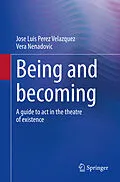Many people spend considerable time seeking a sense of purpose in life and, concomitant with that, a sense of personal identity. This book demystifies this search, revealing why this search is a fallacy. The purpose is to inform readers about results in neuroscience and biophysics that may guide us to some liberation needed in the current age of great complexity in life with a diverse burden of chores; a deliverance from some afflictions that prevent individuals from achieving the true purpose of our lives. Among these afflictions we find two primordial concerns: the belief and subsequent attachment to a self, and the conviction that life must have a deep purpose in which we are major players. While this is a scientific text, it can easily be read by a lay audience, written with minimal technical jargon and with references to scientific papers enough to satisfy the curious. We have tried to extract the essence of scientific observations such that we can glimpse at those aforementioned concerns about the self and life, observations which help us comprehend what we are and what we become, the being and becoming of our own selves and natural phenomena around us.
Jose Luis Perez Velazquez received a PhD in Molecular Physiology & Biophysics. His research seeks principles of biological organisation. He worked at the Hospital for Sick Children in Toronto and was Professor at the University of Toronto. Currently he is a Research Scholar at the Ronin Institute and lives in the natural paradise of Asturias, in Northern Spain.
Vera Nenadovic is a nurse practitioner, neuroscientist and entrepreneur. She has 30 years of experience in healthcare from First Nations communities to intensive care units. Her research focuses on predicting brain injury outcomes. She is a clinician and researcher at Holland Bloorview Kids Rehab Hospital. Her startup company BrainsView is commercializing software that analyzes brainwaves to monitor brain function and recovery after head injury. She is married and lives in Toronto, with her husband and Rottweiler.
Autorentext
Jose Luis Perez Velazquez was born in Zaragoza (Spain) and received an undergraduate degree in Biochemistry and a PhD in Molecular Physiology & Biophysics. His research attempts at understanding the brain-behaviour relation at a high level of description, seeking principles of biological organisation. He worked as a Senior Scientist at the Hospital for Sick Children in Toronto and was Professor at the University of Toronto, where he taught a graduate course on consciousness and self-awareness. Currently he is a Research Scholar at the Ronin Institute and lives in the natural paradise of Asturias, in Northern Spain.
Vera Nenadovic is a nurse practitioner, neuroscientist and entrepreneur. She has 30 years of experience in healthcare from First Nations communities to intensive care units. Her research focuses on predicting brain injury outcomes, particularly in pediatrics. She is currently a clinician and researcher at Holland Bloorview Kids Rehab Hospital. Her startup company BrainsView is commercializing software that analyzes brainwaves to monitor and track brain function and recovery after head injury. She is married and lives in Toronto, with her husband and Rottweiler.
Inhalt
Part I The Neuroscience Perspective Where is my self?
1. The emergence of the self
1.1 Perception is everything
1.2 The usefulness of brains
1.3 Cognition without a brain: the thinking slime mould
1.4 A brief tour through the brain, for the non-specialist tourist
1.5 The cognitive powers of a worm
1.6 On the essence of selves: properties are all we perceive
1.7 The personal identity of animals: a self through the looking glass1.7.1 The mirror test
1.8 Of animals and babies: the development of self-awareness in humans
1.8.1. The body in the brain
1.8.2 Our starting consciousness in our early times
2. The origins and the fallacy of a central commander in the brain: the emergence of agency and the demise of the concept of free will
2.1 Incorrect body perceptions: illusions of ownership and out of body experience
2.1.1. The mind out of the body out of body experiences
2.1.2. A mini science project: elucidating the intriguing phenomenon of OBEs in blind individuals
2.2 Free will, or what is free in that will
2.2.1 The making of choices In search of the last ventriloquist
2.2.2 The will in epileptic patients what seizures reveal about volition
Postscript to section 2
3. The strange world of split brain patients: in search of the interpreter of our
actions
3.1 Closing the coffin of free-will
4. Dissociative identity disorders. Are multiple personalities ever lonely, or, can a
psychiatrist charge twice a person with dual personality?
5. The enduring self, or how to annihilate the self
6. A recipe for high cognition: is consciousness and self-awareness a matter of numbers?
7. Demystifying consciousness
7.1 On emergence
7.1.1. A criticism and a reply
7.2 Perception is personal The essence and source of the mystery
Postscript to part I
Part II The Biophysics perspective What is my life?
8. The Biophysics perspective What is my life?
8.1 Preparing to cook life
8.1.1 Global regularity from local mess The beginnings of the living
8.1.2 Noisy surroundings: when noise really makes sense
8.1.3 A fluctuating world
9. Let there be life
9.1 Molecular crowding: a tale of the most probable
9.2 Biological compartmentalization Good borders make good neighbours9.3 Clarifying the entropic fallacy
9.3.1 And furthermore, clarifying other closest relatives of entropy
9.4 And yet another fallacy: (wo)man and machine
9.5 The dance of the genes
10. The special ones
11. The enduring life
12. And why there is something instead of nothing
Postscript to part II
Part III The philosophical perspective How do I experience reality?
13. The self and consciousness throughout history
14. The power of contemplation Explorations on the self and consciousness in the Buddhist tradition
